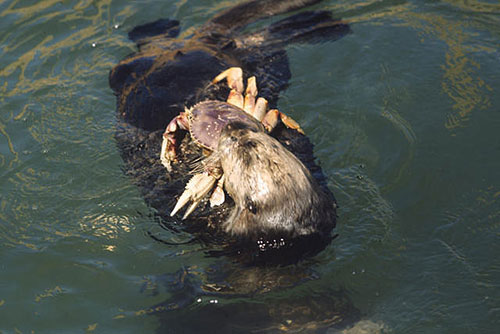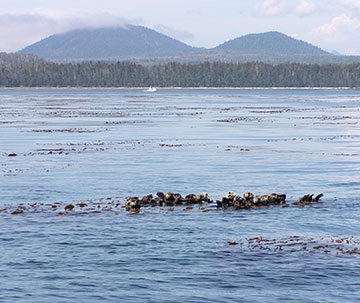Alaska Fish & Wildlife News
December 2013
Sea Otter Numbers – and Harvest – On the Rise

Southeast Alaska and the state as a whole is seeing an upswing in sea otter hunting. According to numbers compiled by the US Fish and Wildlife Service, 2013 will yield the biggest reported harvest on record for the marine mammals, which can only be hunted by Native Alaskans from coastal communities.
US Fish and Wildlife Service records show that for 2012, Alaska Native hunters in coastal communities across the state reported a harvest of 1,281 sea otters. 952 of those were from Southeast, including Yakutat. So far, this year’s harvest is at least 1,380 statewide. That includes 1,008 from Southeast. The agency expects the number to grow by the end of the year, since a lot of the harvest takes place in the fall.
“This year is one of the biggest years on record, actually it’s the biggest year of harvest,” said biologist Brad Benter, who runs the US Fish and Wildlife Service’s marking and tagging program for sea otters in Alaska. “Every community in Alaska where Alaska Natives live and sea otters exist, we have a representative tagger. So when somebody harvests a sea otter, they will go to a tagger in the nearest community and they will get their animal, we call it tagged, or sealed, and scientific harvest information is also collected for each animal on location, sex, age, other animals present. We get a tooth to try to get an age of the animal.”
Fish and Wildlife’s harvest numbers do not reflect unreported or illegal kills by non-Natives. Under the marine mammal protection act, sea otters may only be hunted by coastal Alaska Natives. There is no set season, bag limit, or permit needed but hunters are required to report their kills.
There have been ups and down depending on the community but the overall, the agency’s numbers show the harvest has been on the increase in at least the past half-decade.
US Fish and Wildlife Service biologist Verena Gill thinks there are various factors that have contributed to that. “You know the most obvious one as a biologist is that the (otter) population is increasing in Southeast Alaska and in Southcentral Alaska,” she said.
Between 2002 and 2011, the number of Southeast otters increased from about 11,000 to around 26,000 animals, according to the agency’s latest population assessment, which is expected to be finalized soon.

Gill said the data provided by hunters is valuable for otter research and management:
“I’m very, very appreciative to the hunters that get their animals tagged because we get all this information that help us make a lot of management decisions,” she said. Hunters also share information that provides insights into health and disease of sea otters in the near shore ecosystem, for example, reports of algal blooms (known as red tides, which can cause paralytic shellfish poisoning) and what that’s doing to the sea otters or the shellfish.
The fur trade wiped out the Southeast sea otter population by the early 20th century. Today’s otters are descended from about 400 animals (from the Aleutians) reintroduced to the region in the 1960’s. The otter’s rapid population growth and voracious appetite for shellfish has been a major concern for commercial crabbers, dive fishermen and fishery managers, who blame the animals for a loss of productive fishing grounds. That’s prompted efforts to encourage more hunting, including controversial legislation that proposed a state bounty for lawfully-harvested otters. Federal officials have said such a payment would be illegal under federal law.
According to Gill, the US Fish and Wildlife Service and the University of Alaska are working together to assess how much harvest is sustainable.
“We’re going to begin a project here to look at sustainability, using the very data that the hunters provide,” Gill said. "You know, we get the animals aged by their teeth so we can tell exactly to the year how old they are and then looking at the age and the sex and the location, and then creating a model to really look at sustainability, not just at Southeast Alaska but smaller areas because population varies within a large area too.”
“A sustainable harvest is extremely important to us,” says Lee Kadinger, Chief Operating Officer for Sealaska Heritage Institute. The institute administers the regional native corporation’s cultural and educational programs, which include the use of otter hides.

“What we’ve been working very closely with fish and wildlife service on is what is that potential biological removal rate and we’re far from that but it is something that we are working closely with them and we are insuring that the harvest that we have will be sustainable and will be able to continue in the long term,” said Kadinger
A few years ago, the institute started offering classes in the native art of skin-sewing. At first, it focused on seal skin moccasins.
“And it was out of those classes that we had many people that had an interest in working with sea otter. They just didn’t have the skills passed down to them. They weren’t aware how to do it so much. And there were significant questions out there about whether they even could do it and what they could or could not make,” says Kadinger.
The institute is a registered agent with Fish and Wildlife which means it can purchase otter skins from native people for its programs. Kadinger says each student in the class is provided with a tanned hide and there has been a lot of participation across the region.
“Every class that we’ve had has filled and had a waiting list in each community that we’ve gone to. So, it’s extremely popular. I know when we offered the class here in Juneau (with) 15 slots. The first day we had 54 applications that were submitted. People were highly interested and we were overwhelmed by the interest. And this was the exact same in rural communities as well. Extremely popular and classes were filled,” he said.
The institute has been promoting the development of a cottage, skin-sewing industry for native crafters. Meanwhile, federal officials say they are still working to clarify rules on the sale of sea otter handicrafts and clothing outside the native community. That’s been an on-going concern for native hunters and artisans who say regulatory language and enforcement actions have discouraged their use of the animals.
Matt Lichtenstein is a journalist with KFSK radio in Petersburg, Alaska. This story first aired on KFSK on Nov. 12, 2013, and was posted on the KFSK website and is reprinted with permission.
Subscribe to be notified about new issues
Receive a monthly notice about new issues and articles.
